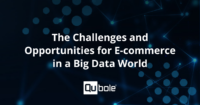
The digital advertising industry is evolving like never before. The ability to capture and analyze massive amounts of structured and unstructured data is helping digital advertisers to discover new relationships, spot emerging trends, and patterns, and gain actionable insights that lead to competitive advantage. As a result, traditional advertising is shifting rapidly into the realm of personalized and highly targeted online and mobile ads—the realm of data-driven marketing. Once dismissed as a “buzzword”, big data is having a big impact on the digital advertising industry, and here are some reasons why.
Finding order among chaos
Successful digital advertising depends upon the ability to collect, integrate and analyze data from both internal and external sources. The challenge lies in the fact that 80% of that data is unstructured or “chaotic”. This is data from sources such as photos, videos, and social media posts—data that says so much about us—but cannot be analyzed via traditional methods. By using big data analytics platforms, companies are now able to capture, store and analyze all collected data, both structured and unstructured. As a result, digital advertisers can gain fresh and relevant insights from raw chaotic data. Actionable insights that inform marketing decisions and strategies.
Real-time data analysis
In the past, conventional scalable relational database solutions could be relied upon to effectively manage and analyze massively large data sets. But they did so at a snail-like pace, taking days and even weeks to perform tasks that often yielded “stale” results. By contrast, the big data analytics platforms of today can perform sophisticated processes at lightning-fast speeds, allowing for real-time analysis and insights. A shorter time to insight allows marketers to make real-time decisions and take immediate action based on fresh, reliable, and relevant information.
More personalized and targeted ads
Big data allows digital advertisers to better target users with more personalized ads that they most likely want to see. Google, and now Facebook—the dominant players in digital advertising—have gotten very good at creating and delivering more appealing ads in non-intrusive ways. Ads featuring products and services we might actually want and use to better our lives. And these more personalized and targeted ads are all based on massive amounts of personal data we constantly provide about what we’re doing, saying, liking, sharing—and now thanks to our mobile devices—where we’re going. This brings us to…
Hyper-localized advertising
The proliferation of mobile devices, primarily smartphones, has created a major opportunity for digital advertisers to deliver mobile-specific ads to the right people at the right time—in context. Through the combination of social data and location data, stores that shoppers are near and might be interested in can send out ads offering percentage discounts or other incentives—delivered to the shopper’s location in real-time—to get them to walk through their doors. Hyper-localized advertising has been shown to increase customer engagement and conversion rates. However, there is potential for backlash as some customers may get a creepy feeling upon realizing that advertisers actually know where they are in real-time. As a result, advertisers will need to make some tradeoffs in order to keep their ads effective while mitigating offenses.
Mergers and acquisitions
In the world of digital-based advertising—a world primarily dominated by Google and Facebook—more corporate mergers and acquisitions will need to take place in order for companies to gain the economies of scale needed to compete against the giants. It was for that very reason that the recent merger of the French advertising company Publicis with the American advertising company Omnicom took place. The merger serves as a cautionary tale for advertisers as they go digital. Going forward, only those companies that have the talent, tools, and infrastructure needed to compete in the high-stakes digital advertising industry will survive.
While digital advertising comprises about 25% of today’s total advertising spend, the full impact of big data will be felt in the future when all advertising will be data-driven.
How QDS Can Help Digital Advertisers
Qubole Data Service (QDS) offers a fully elastic Hadoop engine, providing digital advertisers with the analytics power they need to extract meaningful information from unstructured data to gain actionable insights and competitive advantage.
Read about how an award-winning digital advertising agency utilized the Big Data insights provided by QDS to optimize the digital campaign performance of its clients through more personal and targeted marketing.
Amassing large amounts of data in real-time is a serious concern for many advertisers looking to stay competitive in the industry. Komli Media, Asia Pacific’s leading media technology company, was challenged with managing the volume of user data and turned to Qubole Data Service to help with their Big Data processing requirements. “[QDS’s] advanced features such as auto-scaling and S3 I/O optimization provide more flexibility and faster turnaround time to support the needs of our business users,” says Shailesh Garg, Engineering Manager at Komli Media. Read more about how Qubole was able to help Komli Media reach targeted audiences efficiently and at scale.



